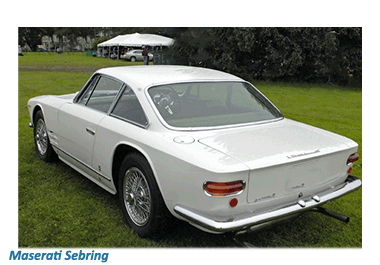
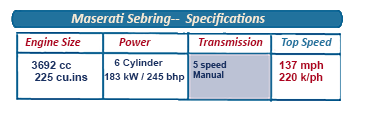 Maserati called on Turin based design studio, Vignale to handle the styling, and once again they came up with a styling that was as graceful as it was purposeful.
Reportedly Maserati were considering naming this new/old model the 3500 GTI, to promote the fact that it was available with a fuel injection engine.
Maserati called on Turin based design studio, Vignale to handle the styling, and once again they came up with a styling that was as graceful as it was purposeful.
Reportedly Maserati were considering naming this new/old model the 3500 GTI, to promote the fact that it was available with a fuel injection engine.
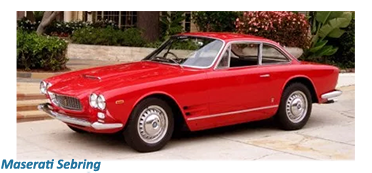 Early teething problems with the engine hastened the decision to drop the GTI suffix and adopt the Sebring title instead, the name reviving Maserati's past glories on the race track.
The Sebring was initially promoted as a full 2+2, although, in truth, rear seat accommodation was very limited, really suitable for hand luggage only.
Early teething problems with the engine hastened the decision to drop the GTI suffix and adopt the Sebring title instead, the name reviving Maserati's past glories on the race track.
The Sebring was initially promoted as a full 2+2, although, in truth, rear seat accommodation was very limited, really suitable for hand luggage only.
 Sebring buyers were given a choice of two engines, the standard 3485 cc or a more powerful 3694cc unit.
Sebring buyers were given a choice of two engines, the standard 3485 cc or a more powerful 3694cc unit.
![]()
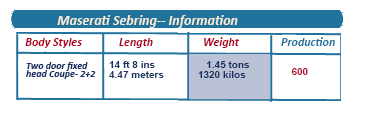 ti Sebring was a well-specified car, coming with a five-speed ZF manual gearbox, disc brakes as standard with three-speed automatic optional.
ti Sebring was a well-specified car, coming with a five-speed ZF manual gearbox, disc brakes as standard with three-speed automatic optional.
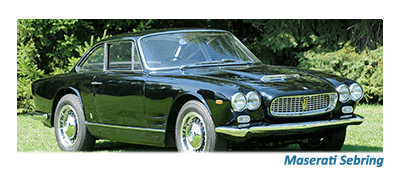 Options included air conditioning, special paint, radios and wire wheels and even the choice of a fuel injection engine. The latter invariably proved troublesome, though, and many Sebring engines were converted to carburettor driven.
Maserati's< successor to the 3500GT series wore a more modem body atop the former tubular-steel chassis and basic drivetrain.
Although most of the body was made out of steel, an alloy boot lid and bonnet were fitted.
All Sebring bodies were produced for Maserati by Vignale: two-seat notchback coupes (with occasional rear seats) displaying a straight-through fender line from front to rear.
Options included air conditioning, special paint, radios and wire wheels and even the choice of a fuel injection engine. The latter invariably proved troublesome, though, and many Sebring engines were converted to carburettor driven.
Maserati's< successor to the 3500GT series wore a more modem body atop the former tubular-steel chassis and basic drivetrain.
Although most of the body was made out of steel, an alloy boot lid and bonnet were fitted.
All Sebring bodies were produced for Maserati by Vignale: two-seat notchback coupes (with occasional rear seats) displaying a straight-through fender line from front to rear.
![]()
